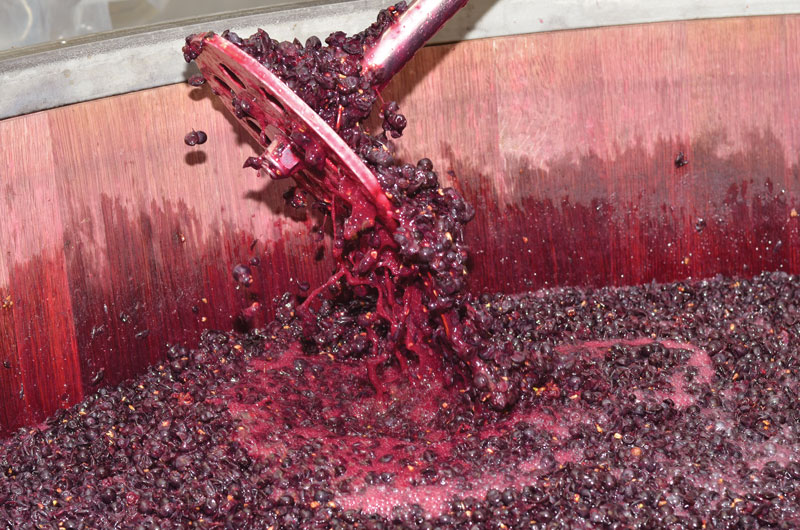Wine Wizard
Troubleshooting Off-Odor in a Viognier
Viognier can be a bit of an odd duck. Like Riesling, it can get some of those weird petrol/gas like aromas, and that’s just natural, from the grapes. Like Sauvignon Blanc, it
Barrel-Aging Question
Unfortunately, with a small barrel like that, you’re going to have a high ratio of oxygen:wine. If you think about a traditional-sized barrel, it’s about 59 gallons (225 L); there’s a lot
A Corker Conundrum
I hope I’m assuming correctly, but I’m imagining that you’ve got the smaller, lighter-weight red metal corker with adjustable spring-loaded bottle base and plastic jaws, sometimes called a “Portuguese” corker. These are
Knocking Down Rot On Grapes
That’s a great question as we approach the harvest season. Though I don’t expect 2019 harvest to be like 2011 or 1998, many of us all over the country, from Oregon to
Decanting Advice
Those are a great couple of questions. Decanting, or the pouring of a wine out of its bottle into another, larger container (usually made of clear glass or crystal), is something that
Affects of Acid
In general, I think of how TA (titratable, or total acidity) and pH impact flavor and mouthfeel in this simple (and yes, perhaps simplistic) way: TA determines how tart or sour a
Determining A Wine’s Ageability
I’ll answer your last questions first and then give you my thoughts on the age-worthiness of your wine. RS (residual sugar) “Dry” (no sugar remaining) is usually considered 0.2% or less (2
Yeast choice for a fruit wine
You want to know what my standard, go-to, never-fail, keeps-most-wines-happy yeast is? It’s called Prise de Mousse, EC1118, Davis 796 or Premier Cuvee. Why all the names? I guess so a lot
Cane Juice Wine
That’s coming is a long answer but I hope it will speak to the many possible country wine situations in which you may find yourself. A good number of our readers choose
Sugar Conversion Tables
For the WineMaker’s Answer Book I referenced the Table 1-2, Appendix 1, from Wine Analysis and Production, Zoecklein et al, 1995 for the Specific Gravity to Brix tables. Note that this conversion
Dealing With Persistent Sediment
Goodness, you’ve got a persistent sediment source in your wines that’s for sure. You’ve removed the gross particles by racking and filtration.You’ve cleared out proteins by using bentonite. You’ve taken out excess
Softening The Wine
Before I launch into my information about gum arabic and related products, do take a minute to think that gum arabic may not give you the result you’re looking for. Gum arabic
Properly Adding Acid to a Barrel
I agree with you in that acid adjustments, especially big ones, can best be made in two steps. That way you can see if you like the result as you go along.
Reconfiguring Your Tasting Palate
I apologize in advance for the lengthy response but this is a fantastic question and I really wanted to flesh out my answer for you and readers that are following along. You
Increasing A Wine’s Mouthfeel
I feel ya! (Yes, pun intended.) Since I don’t have much space left in this column, let me break it down for you in bite-sized pieces. Much more food for thought and
Discussing Pros v. Cons of Pinot Noir
Pinot Noir has quite a reputation. Often known as the “Heartbreak Grape” and lovingly discussed, dissected, and degustated (is that even a word?) by rabid Pinot-philes the world over, Pinot Noir was
Chilled Red Wines
Though especially welcome in summertime, and especially tasty with regards to Pinot Noir, I break the “room temperature reds rule” year round and with many varietals to boot. In the depths of
Gum Arabic
Here goes some gum arabic info . . . I was first introduced to it at Bonny Doon when Randall Grahm brought it back from one of his jaunts to France, around
Acetobacter Problems
Well, it seems like you have been paid a visit by a colony of Acetobacter, aka acetic acid bacteria. They love air, eat alcohol, and turn it into carbon dioxide and vinegar.
pH Reanalysis
The answer to your question depends on the size of your batch. The bigger your batch, especially if it’s must all mixed together with juice and skins, you need to mix quite
Sulfite Timing Question
That’s a great question with a very simple answer. You should not add postassium metabisulfite (SO2, or sulfur dioxide) to your wine between primary and secondary fermentation. Because the SO2 will inhibit
Cork Variability
You’re absolutely right, raised corks can either be a problem (if they’re too high, or too high of a percentage from bottle-to-bottle) or it could be nothing at all. The devil is
The Sulfite Blues
Your nose (bruised apple/sweet smell) and your chemical analysis (loss of Free SO2) are telling me that you have an oxygen ingress problem and aldehydes and perhaps an increase in VA (volatile
Passion Fruit Wine
Well, I will admit I have never made a passion fruit wine (living in Napa, those pesky grapes just seem to be the most convenient sugar source at hand) but I will
Brown Colored White Wine
Sorry to say, but it sounds like you’ve got a no-bueno situation. White grapes should always be pressed as soon as possible after picking in order to reduce juice (and subsequent wine)
